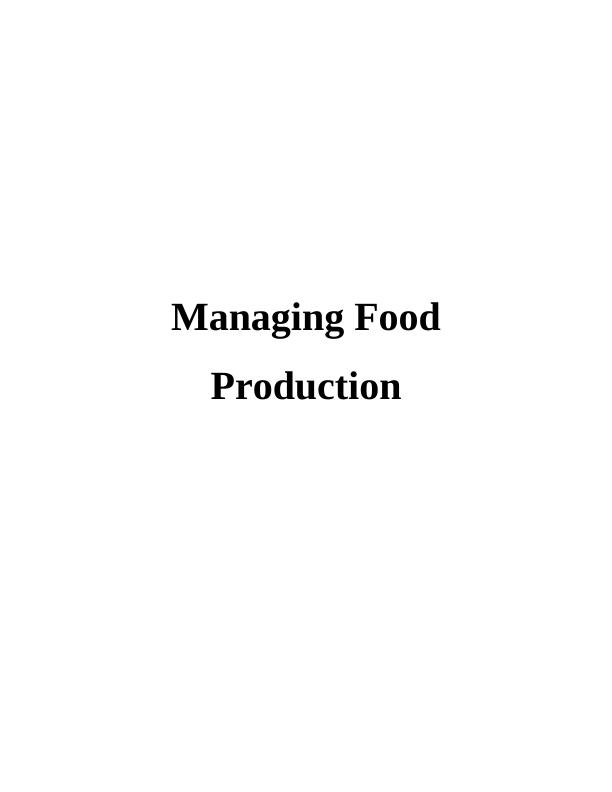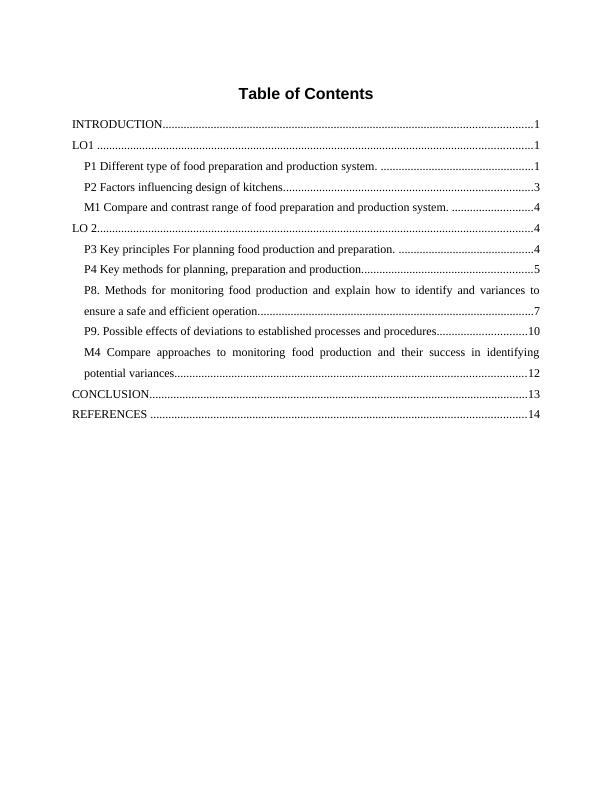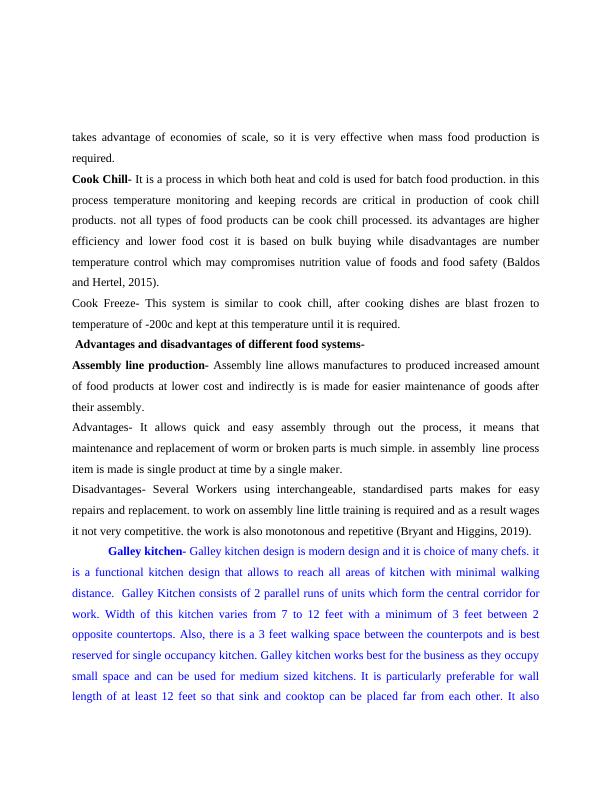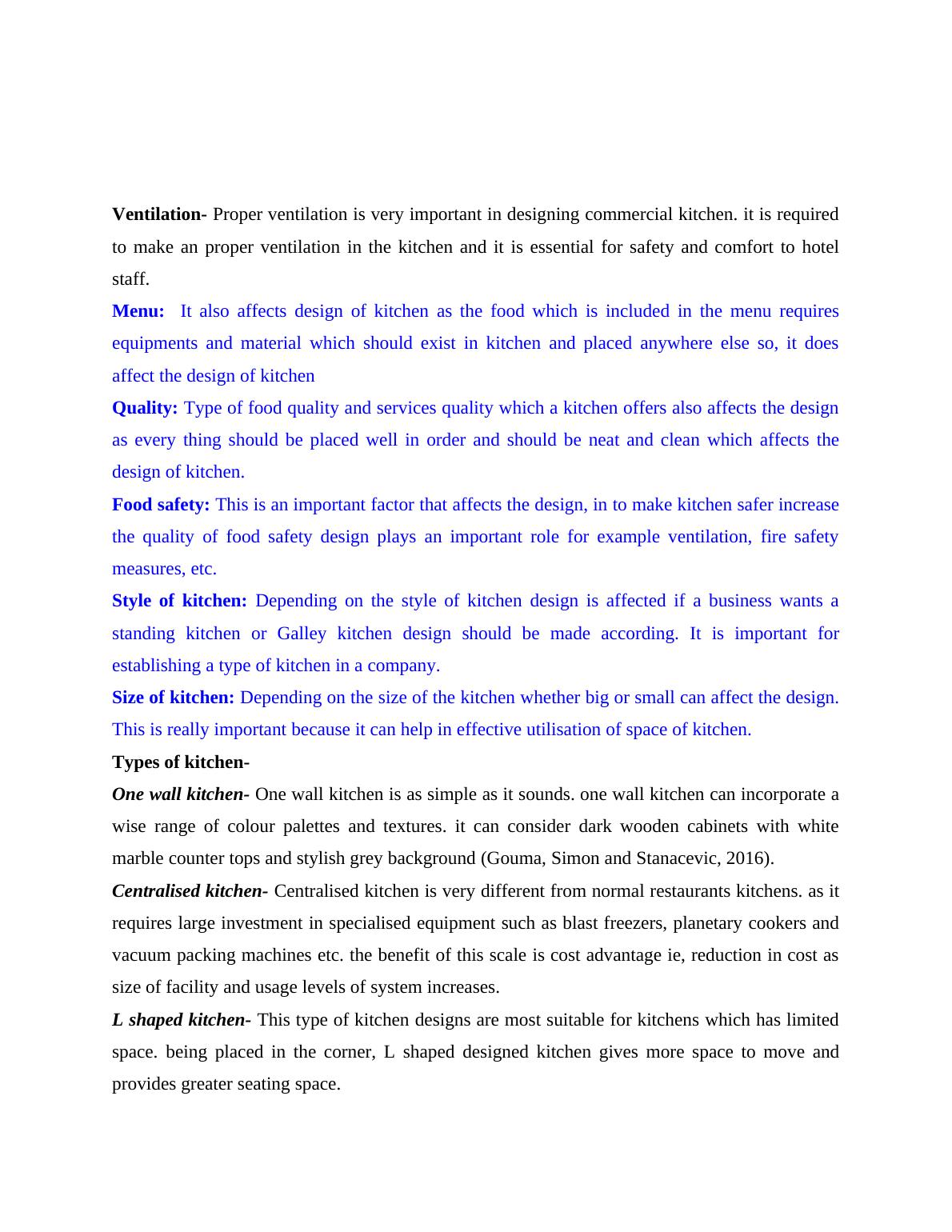Managing Food Production
25 Pages7343 Words1 Views
Added on 2023-01-19
About This Document
This document discusses different types of food preparation and production systems, factors influencing kitchen design, and key principles for planning food production and preparation. It covers topics such as traditional and centralized food production systems, factors affecting kitchen design, and principles for ensuring food safety and quality. The document also compares and contrasts different food production systems in the context of a Galley Kitchen design. Suitable for students studying food production management or related courses.
Managing Food Production
Added on 2023-01-19
ShareRelated Documents
Managing Food
Production
Production

Table of Contents
INTRODUCTION...........................................................................................................................1
LO1 .................................................................................................................................................1
P1 Different type of food preparation and production system. ...................................................1
P2 Factors influencing design of kitchens...................................................................................3
M1 Compare and contrast range of food preparation and production system. ...........................4
LO 2.................................................................................................................................................4
P3 Key principles For planning food production and preparation. .............................................4
P4 Key methods for planning, preparation and production.........................................................5
P8. Methods for monitoring food production and explain how to identify and variances to
ensure a safe and efficient operation............................................................................................7
P9. Possible effects of deviations to established processes and procedures..............................10
M4 Compare approaches to monitoring food production and their success in identifying
potential variances.....................................................................................................................12
CONCLUSION..............................................................................................................................13
REFERENCES .............................................................................................................................14
INTRODUCTION...........................................................................................................................1
LO1 .................................................................................................................................................1
P1 Different type of food preparation and production system. ...................................................1
P2 Factors influencing design of kitchens...................................................................................3
M1 Compare and contrast range of food preparation and production system. ...........................4
LO 2.................................................................................................................................................4
P3 Key principles For planning food production and preparation. .............................................4
P4 Key methods for planning, preparation and production.........................................................5
P8. Methods for monitoring food production and explain how to identify and variances to
ensure a safe and efficient operation............................................................................................7
P9. Possible effects of deviations to established processes and procedures..............................10
M4 Compare approaches to monitoring food production and their success in identifying
potential variances.....................................................................................................................12
CONCLUSION..............................................................................................................................13
REFERENCES .............................................................................................................................14

INTRODUCTION
The food safety and monitoring is very important for every food industries and also
helpful for the companies to improve their kitchen, because it is the chef which are the only one
who is responsible for deciding the future of the company. A company in order to improve its
kitchen should have proper design and has to follow the principles proper methods of preparation
and production of food. In order to improve kitchen there are different ways for doing it like
promoting hand washing, washing food properly cooking at right temperatures.
Within the kitchen, equipment and preparation surfaced should be sanitised and cleaned
properly and one of the best way is to train the staff. This report is all about the different types
of food preparations and the production systems and the advantages and disadvantages of
different food systems, different factors that can affect the food production. It also includes the
various principles of HACCP that is helpful in monitoring the food safety and the various
measures that con improve the process and production of the food product.
LO1
Different type of food preparation and production system.
Food system includes process and infrastructure which is involved in feeding a
population, harvesting, growing, packaging, transporting, marketing, consumption and disposal
of food and food related items. Types of food production system is as follows:
Traditional- In this type of food production ingredients are assembled and the foods produced, h
on site, weather heated or chilled it is served to consumers. food is purchased along with food
processing continuum. is traditional other items are may be purchased with some processing and
others may be purchased when it is fully prepared (Bader and Jagtap, 2020), it only require
portioning and services.
Centralised- The commissary food service system is also known as central kitchen and central
food production. in this type of production food is transported to satellites, where it is served to
consumers. in this process labour cost is lower because of centralisation of food preparation. is
The food safety and monitoring is very important for every food industries and also
helpful for the companies to improve their kitchen, because it is the chef which are the only one
who is responsible for deciding the future of the company. A company in order to improve its
kitchen should have proper design and has to follow the principles proper methods of preparation
and production of food. In order to improve kitchen there are different ways for doing it like
promoting hand washing, washing food properly cooking at right temperatures.
Within the kitchen, equipment and preparation surfaced should be sanitised and cleaned
properly and one of the best way is to train the staff. This report is all about the different types
of food preparations and the production systems and the advantages and disadvantages of
different food systems, different factors that can affect the food production. It also includes the
various principles of HACCP that is helpful in monitoring the food safety and the various
measures that con improve the process and production of the food product.
LO1
Different type of food preparation and production system.
Food system includes process and infrastructure which is involved in feeding a
population, harvesting, growing, packaging, transporting, marketing, consumption and disposal
of food and food related items. Types of food production system is as follows:
Traditional- In this type of food production ingredients are assembled and the foods produced, h
on site, weather heated or chilled it is served to consumers. food is purchased along with food
processing continuum. is traditional other items are may be purchased with some processing and
others may be purchased when it is fully prepared (Bader and Jagtap, 2020), it only require
portioning and services.
Centralised- The commissary food service system is also known as central kitchen and central
food production. in this type of production food is transported to satellites, where it is served to
consumers. in this process labour cost is lower because of centralisation of food preparation. is

takes advantage of economies of scale, so it is very effective when mass food production is
required.
Cook Chill- It is a process in which both heat and cold is used for batch food production. in this
process temperature monitoring and keeping records are critical in production of cook chill
products. not all types of food products can be cook chill processed. its advantages are higher
efficiency and lower food cost it is based on bulk buying while disadvantages are number
temperature control which may compromises nutrition value of foods and food safety (Baldos
and Hertel, 2015).
Cook Freeze- This system is similar to cook chill, after cooking dishes are blast frozen to
temperature of -200c and kept at this temperature until it is required.
Advantages and disadvantages of different food systems-
Assembly line production- Assembly line allows manufactures to produced increased amount
of food products at lower cost and indirectly is is made for easier maintenance of goods after
their assembly.
Advantages- It allows quick and easy assembly through out the process, it means that
maintenance and replacement of worm or broken parts is much simple. in assembly line process
item is made is single product at time by a single maker.
Disadvantages- Several Workers using interchangeable, standardised parts makes for easy
repairs and replacement. to work on assembly line little training is required and as a result wages
it not very competitive. the work is also monotonous and repetitive (Bryant and Higgins, 2019).
Galley kitchen- Galley kitchen design is modern design and it is choice of many chefs. it
is a functional kitchen design that allows to reach all areas of kitchen with minimal walking
distance. Galley Kitchen consists of 2 parallel runs of units which form the central corridor for
work. Width of this kitchen varies from 7 to 12 feet with a minimum of 3 feet between 2
opposite countertops. Also, there is a 3 feet walking space between the counterpots and is best
reserved for single occupancy kitchen. Galley kitchen works best for the business as they occupy
small space and can be used for medium sized kitchens. It is particularly preferable for wall
length of at least 12 feet so that sink and cooktop can be placed far from each other. It also
required.
Cook Chill- It is a process in which both heat and cold is used for batch food production. in this
process temperature monitoring and keeping records are critical in production of cook chill
products. not all types of food products can be cook chill processed. its advantages are higher
efficiency and lower food cost it is based on bulk buying while disadvantages are number
temperature control which may compromises nutrition value of foods and food safety (Baldos
and Hertel, 2015).
Cook Freeze- This system is similar to cook chill, after cooking dishes are blast frozen to
temperature of -200c and kept at this temperature until it is required.
Advantages and disadvantages of different food systems-
Assembly line production- Assembly line allows manufactures to produced increased amount
of food products at lower cost and indirectly is is made for easier maintenance of goods after
their assembly.
Advantages- It allows quick and easy assembly through out the process, it means that
maintenance and replacement of worm or broken parts is much simple. in assembly line process
item is made is single product at time by a single maker.
Disadvantages- Several Workers using interchangeable, standardised parts makes for easy
repairs and replacement. to work on assembly line little training is required and as a result wages
it not very competitive. the work is also monotonous and repetitive (Bryant and Higgins, 2019).
Galley kitchen- Galley kitchen design is modern design and it is choice of many chefs. it
is a functional kitchen design that allows to reach all areas of kitchen with minimal walking
distance. Galley Kitchen consists of 2 parallel runs of units which form the central corridor for
work. Width of this kitchen varies from 7 to 12 feet with a minimum of 3 feet between 2
opposite countertops. Also, there is a 3 feet walking space between the counterpots and is best
reserved for single occupancy kitchen. Galley kitchen works best for the business as they occupy
small space and can be used for medium sized kitchens. It is particularly preferable for wall
length of at least 12 feet so that sink and cooktop can be placed far from each other. It also

enhances the safety of employees and the kitchen particularly when a corridor is narrow. Also
the arrangement focuses on the appliances in one area, it saves the time of chef as they don't have
to turn to opposing run with a potentially dangerous item in the kicthen so, it is suitable for
business and safety.
Advantages- it is easy to divide these types of kitchens into multiple working areas. in this type
of kitchen everything is easily accessible. it has a central design for larger spaces. its is very easy
to clean.
Disadvantages- a galley kitchen layout can sometimes limit the space left in dinner area. its is
very difficult for people to pass out as it may result in traffic jam.
Factors affecting food production system design-
Taste- The taste of food is important to be considered. the main aim for restaurant is to provide
tasty food to consumers. restaurant had to make tasty food so that it can satisfy their customers
(Cai and et.al., 2018).
Cost- The cost plays an important role in the manufacturing of food products. tf the started
charging high prices to customers their products may not be purchased by all people. so cost
plays and important role in production process.
Quality- Food quality is also an important factor which impacts the production process, while
manufacturing food goods it is necessary to ensure that its quality is good not not. as some times
prices sensitive market is there but it is necessary for firm to make control on quality.
P2 Factors influencing design of kitchens.
There are different factors which influences in designing kitchen are as follows-
Budget- Main thing which matters a lot in designing the kitchen is budget. high budget is require
to develop premium quality kitchen. it is a major key factor in designing the kitchen as without
the availability of proper funds the kitchen cabn not be made(Calabro and Vieri, 2017).
Needs and layouts- While designing kitchen it is necessary that needs must be analysed that
what are the requirements of facilities, the kitchen being prepared will full fill the needs or not.
Flooring- The flooring must be made by tile or stone. as when there is heavy traffic stone
flooring must be used. as using stone is more durable than tile.
the arrangement focuses on the appliances in one area, it saves the time of chef as they don't have
to turn to opposing run with a potentially dangerous item in the kicthen so, it is suitable for
business and safety.
Advantages- it is easy to divide these types of kitchens into multiple working areas. in this type
of kitchen everything is easily accessible. it has a central design for larger spaces. its is very easy
to clean.
Disadvantages- a galley kitchen layout can sometimes limit the space left in dinner area. its is
very difficult for people to pass out as it may result in traffic jam.
Factors affecting food production system design-
Taste- The taste of food is important to be considered. the main aim for restaurant is to provide
tasty food to consumers. restaurant had to make tasty food so that it can satisfy their customers
(Cai and et.al., 2018).
Cost- The cost plays an important role in the manufacturing of food products. tf the started
charging high prices to customers their products may not be purchased by all people. so cost
plays and important role in production process.
Quality- Food quality is also an important factor which impacts the production process, while
manufacturing food goods it is necessary to ensure that its quality is good not not. as some times
prices sensitive market is there but it is necessary for firm to make control on quality.
P2 Factors influencing design of kitchens.
There are different factors which influences in designing kitchen are as follows-
Budget- Main thing which matters a lot in designing the kitchen is budget. high budget is require
to develop premium quality kitchen. it is a major key factor in designing the kitchen as without
the availability of proper funds the kitchen cabn not be made(Calabro and Vieri, 2017).
Needs and layouts- While designing kitchen it is necessary that needs must be analysed that
what are the requirements of facilities, the kitchen being prepared will full fill the needs or not.
Flooring- The flooring must be made by tile or stone. as when there is heavy traffic stone
flooring must be used. as using stone is more durable than tile.

Ventilation- Proper ventilation is very important in designing commercial kitchen. it is required
to make an proper ventilation in the kitchen and it is essential for safety and comfort to hotel
staff.
Menu: It also affects design of kitchen as the food which is included in the menu requires
equipments and material which should exist in kitchen and placed anywhere else so, it does
affect the design of kitchen
Quality: Type of food quality and services quality which a kitchen offers also affects the design
as every thing should be placed well in order and should be neat and clean which affects the
design of kitchen.
Food safety: This is an important factor that affects the design, in to make kitchen safer increase
the quality of food safety design plays an important role for example ventilation, fire safety
measures, etc.
Style of kitchen: Depending on the style of kitchen design is affected if a business wants a
standing kitchen or Galley kitchen design should be made according. It is important for
establishing a type of kitchen in a company.
Size of kitchen: Depending on the size of the kitchen whether big or small can affect the design.
This is really important because it can help in effective utilisation of space of kitchen.
Types of kitchen-
One wall kitchen- One wall kitchen is as simple as it sounds. one wall kitchen can incorporate a
wise range of colour palettes and textures. it can consider dark wooden cabinets with white
marble counter tops and stylish grey background (Gouma, Simon and Stanacevic, 2016).
Centralised kitchen- Centralised kitchen is very different from normal restaurants kitchens. as it
requires large investment in specialised equipment such as blast freezers, planetary cookers and
vacuum packing machines etc. the benefit of this scale is cost advantage ie, reduction in cost as
size of facility and usage levels of system increases.
L shaped kitchen- This type of kitchen designs are most suitable for kitchens which has limited
space. being placed in the corner, L shaped designed kitchen gives more space to move and
provides greater seating space.
to make an proper ventilation in the kitchen and it is essential for safety and comfort to hotel
staff.
Menu: It also affects design of kitchen as the food which is included in the menu requires
equipments and material which should exist in kitchen and placed anywhere else so, it does
affect the design of kitchen
Quality: Type of food quality and services quality which a kitchen offers also affects the design
as every thing should be placed well in order and should be neat and clean which affects the
design of kitchen.
Food safety: This is an important factor that affects the design, in to make kitchen safer increase
the quality of food safety design plays an important role for example ventilation, fire safety
measures, etc.
Style of kitchen: Depending on the style of kitchen design is affected if a business wants a
standing kitchen or Galley kitchen design should be made according. It is important for
establishing a type of kitchen in a company.
Size of kitchen: Depending on the size of the kitchen whether big or small can affect the design.
This is really important because it can help in effective utilisation of space of kitchen.
Types of kitchen-
One wall kitchen- One wall kitchen is as simple as it sounds. one wall kitchen can incorporate a
wise range of colour palettes and textures. it can consider dark wooden cabinets with white
marble counter tops and stylish grey background (Gouma, Simon and Stanacevic, 2016).
Centralised kitchen- Centralised kitchen is very different from normal restaurants kitchens. as it
requires large investment in specialised equipment such as blast freezers, planetary cookers and
vacuum packing machines etc. the benefit of this scale is cost advantage ie, reduction in cost as
size of facility and usage levels of system increases.
L shaped kitchen- This type of kitchen designs are most suitable for kitchens which has limited
space. being placed in the corner, L shaped designed kitchen gives more space to move and
provides greater seating space.

End of preview
Want to access all the pages? Upload your documents or become a member.
Related Documents
Managing Food Production - Doclg...
|22
|6381
|555
Unit 9: Managing Food Productionlg...
|10
|3307
|46
Managing Food Production Systemslg...
|14
|4205
|395
Food Production System - PDFlg...
|15
|4812
|271
Managing Food Production Unit 9lg...
|20
|5745
|74
Managing Food Production: Types, Principles, and Methodslg...
|13
|3299
|1
